The Summer Issue 2023 Eco-anxiety, resilience, and the Lower Saint Lawrence
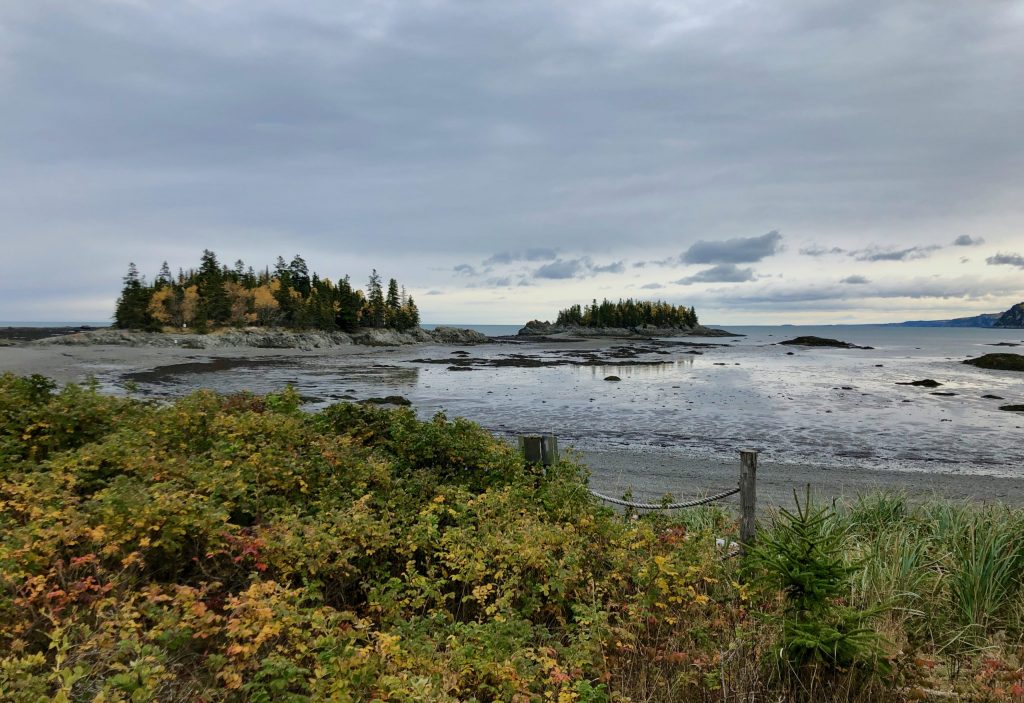 Letter from the Editor
Letter from the Editor
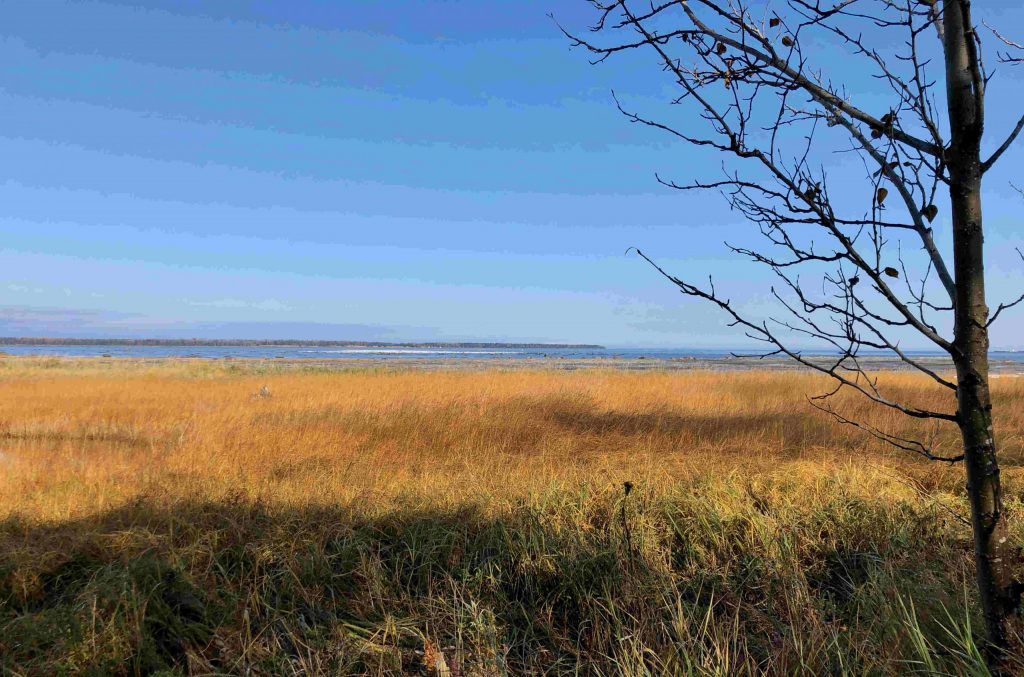 Close to Home
Close to Home
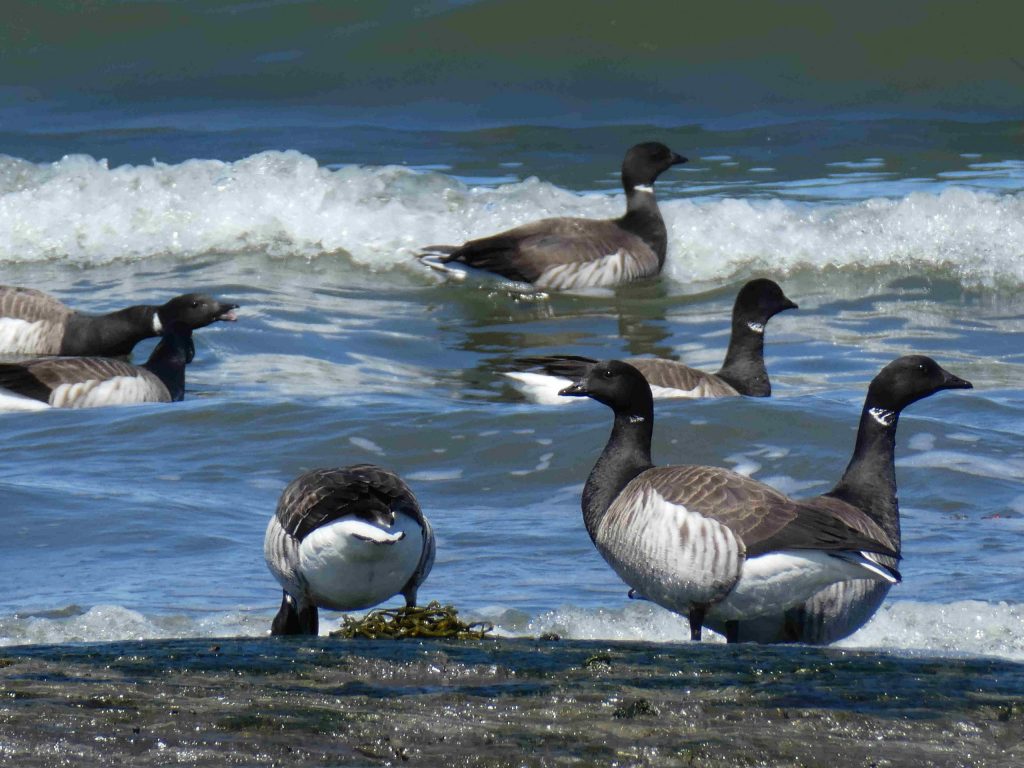 Spring Observations Along the Saint Lawrence Estuary
Spring Observations Along the Saint Lawrence Estuary
 “July, 1953.”
“July, 1953.”
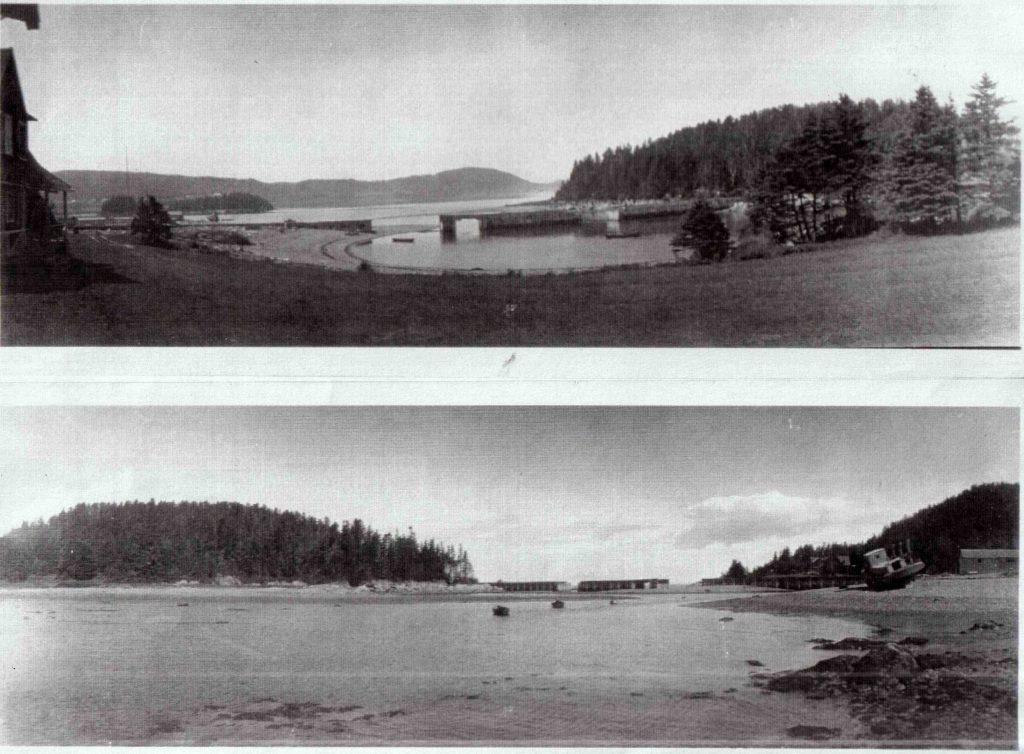 Bic Harbour Massacres
Bic Harbour Massacres
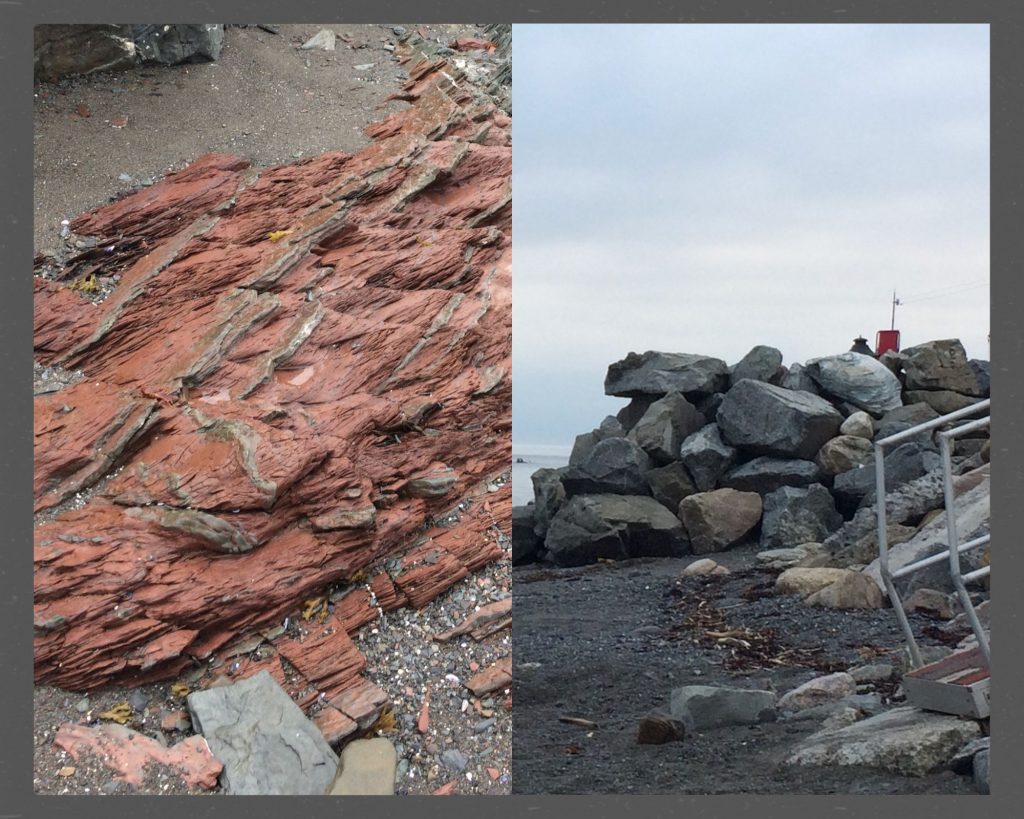 Wake-up Call
Wake-up Call
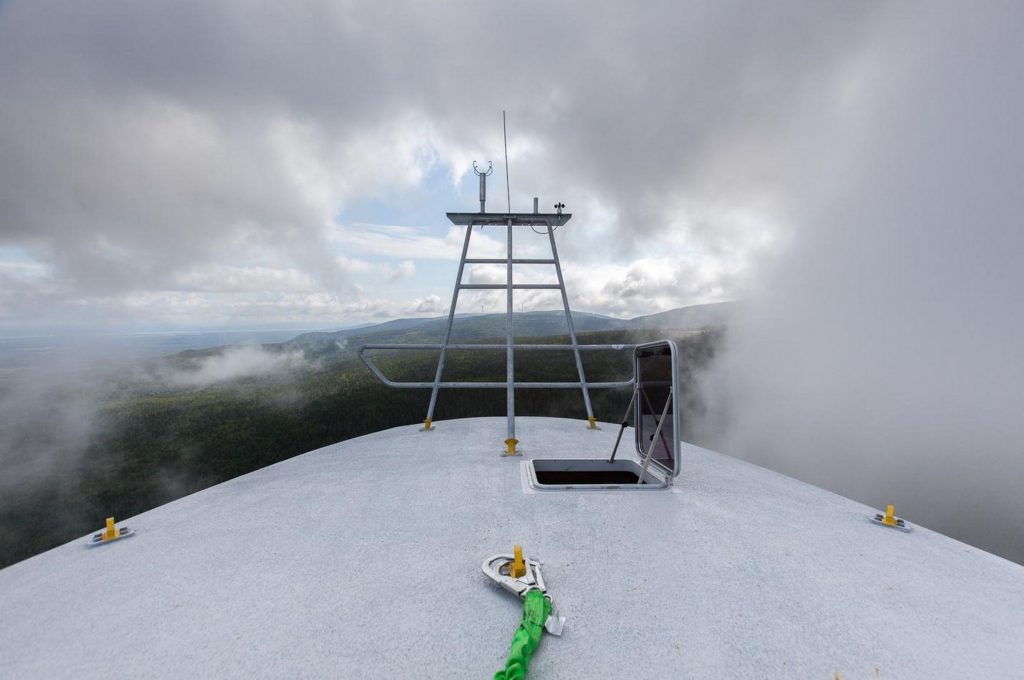 Betwixt Between
Betwixt Between
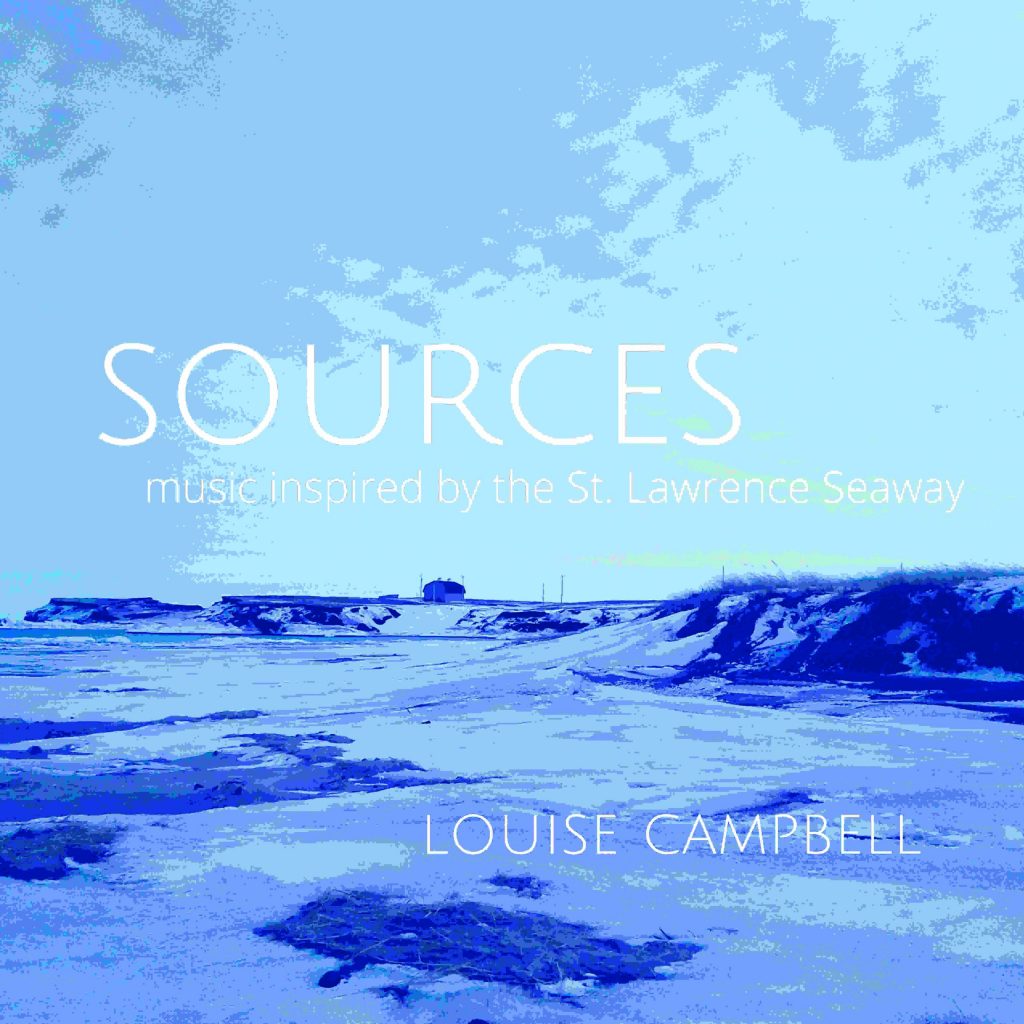 Sources: Music Inspired by the St. Lawrence River
Sources: Music Inspired by the St. Lawrence River
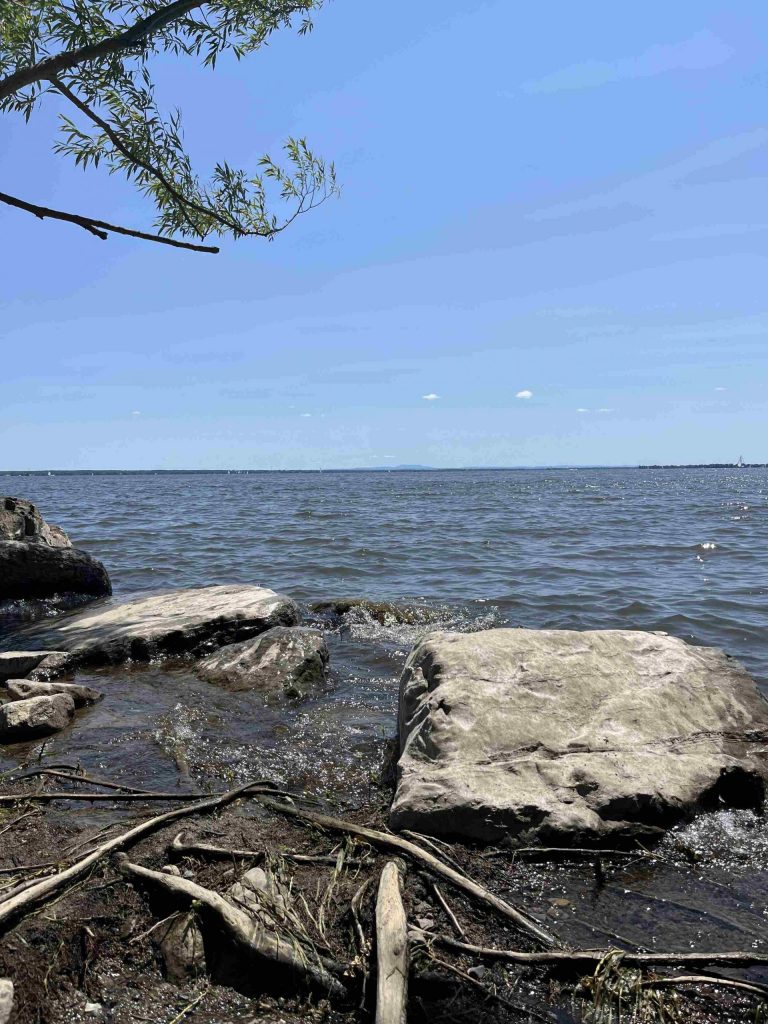 The Whale Encounter
The Whale Encounter
 ‘We’re like a laboratory for climate change’- an interview with Alexander Reford
‘We’re like a laboratory for climate change’- an interview with Alexander Reford
Welcome back to Font, as we continue our new seasonal publishing schedule!
In Summer 2023, Font returns to the Lower Saint Lawrence and Les Jardins de Métis//the Reford Gardens, to explore our relationship and responsibility to the river and to the place in which we make our home in a time of climate crisis and eco-anxiety.
It has been a pleasure to work with new writers and artists with close connections to the area, as well as some returning contributors. For the most part, these are people who have an intimate connection to the region, and have seen both beauty and destruction―and resilience—in their lifetime. Their reflections are linked by the lived truth of seeing their place change over time, and wonderment at how humanity will adapt and ally itself to the changing natural world.
Lisa Wagner and Catherine Parceaud open up the landscape and birdlife to us, while naakita f.k. and Judy Parceaud reflect on historical activities and ghosts. Mary Soderstrom—who also led a wonderful online writing workshop for contributors— and Joan Sullivan explore human coping measures, and the need for changing attitudes, while Alexander Reford discusses with me how the Reford Gardens has adapted its approach over the years.
Ellie Chartier and Caitlin Siemon offer up reflections on the stories of the river, and Louise Campbell leads us down the course of the Saint Lawrence with a track from her stunning new album Sources.
This is a Font issue that feels timely, urgent, and—in the conscience and care demonstrated by each of the contributors—not without hope. We hope that you enjoy.
We acknowledge the financial support of the Government of Canada.
Close to Home
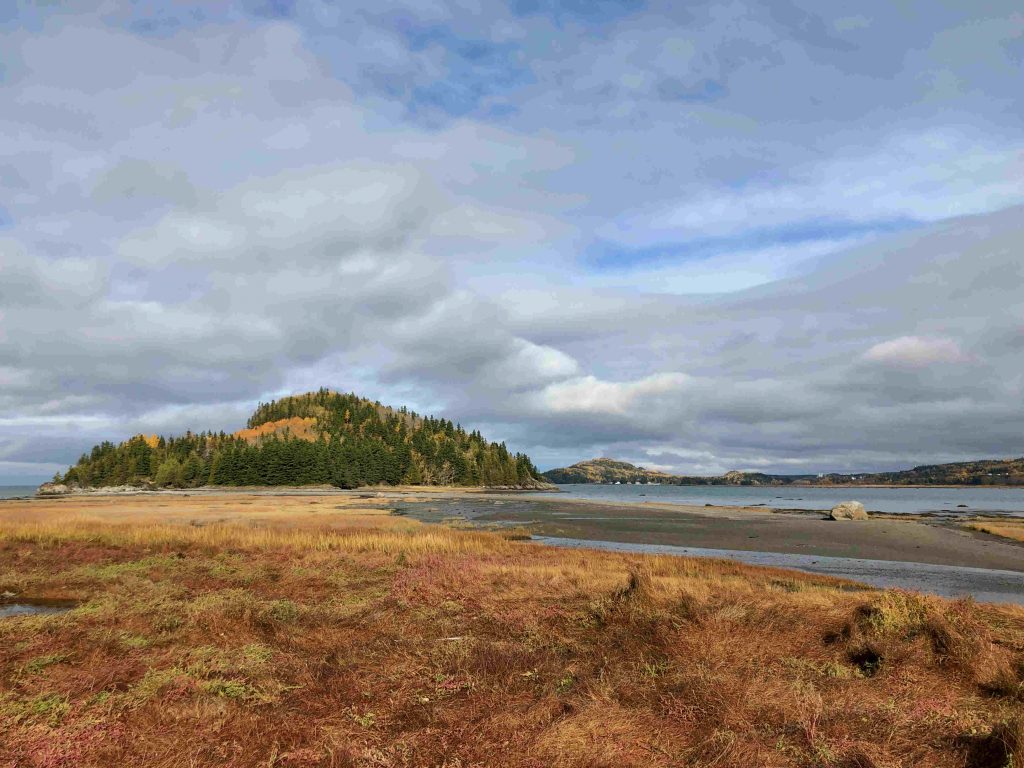
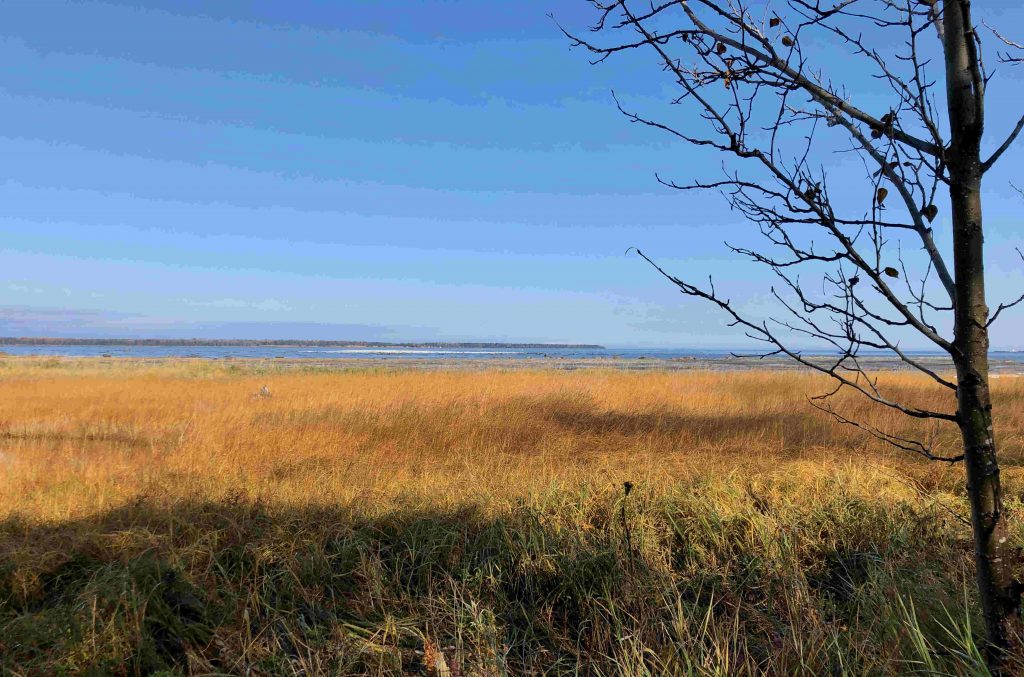


Near where we live, the Saint Lawrence Estuary rims a series of bays, punctuated by rocky upwellings, the cliffs cloaked with firs, aspens, and spruce. I frequently walk a favourite coastal path in Parc national du Bic that traces the water’s edge, revelling in the fresh air and vibrancy of forest and shore. Along the beaches of these bays, the coastal stones have been smoothed by water and ice, collected by waves, and strewn along shore’s edge. Lines of sea wrack, kelp, and mussel shells mark the limits of recent tides.
Our part of the Saint Lawrence feels like seacoast, with distinct tidal amplitudes; low tides find seals resting on exposed rocks. Medium tides bring flocks of eider ducks in late spring. And in summer, the cries of gulls are always present. The murmurs of snow geese come later in fall, as migratory flocks congregate on stopover sites in nearby bays.
Farther from us in both directions, the Saint Lawrence touches land over sand and rock, washing through seagrass and cattails, and splashing against concrete bulwarks. The river system’s almost 1600-kilometre expanse anchors a vast watershed, accumulating rainwater, runoff, and snowmelt. Freshwater flows from Lake Ontario at its western headwaters, mixing with salt water in the estuary, becoming largely salty in the Gulf of Saint Lawrence, as the river merges into the Atlantic Ocean.
The water seeps from farm fields, drains manicured villages, and washes grit-filled urban landscapes, all flowing to streams and rivers that run into the Saint Lawrence. Some of these waters harbour salmon; bass, walleye, trout, and smelt are a few of the species found in the larger river system. Whales, dolphins, and seals frequent the midpoint of the estuary, supported by plankton and other organisms living in the nutrient-rich areas provided by the turnover of fresh and salt water.
All of this exists beneath expansive skies of long horizons and dramatic cloudscapes. The bays change throughout the seasons. In winter, tidal forces create ice mosaics. On one day, they might be covered with thick ice; the next day, the ice may have broken into chunks, rising and falling with the tide. Open water can suddenly appear overnight, too, in warmer winters. It’s remarkable to see these fluctuations, driven by wind, tide, and temperature.
In summer and fall, colour and sheen vary with the hue of the sky and the depth of the water. The quality of light matters, too. Waves and ripples reflect ambient light, sometimes blue, sometimes grey, always different. Wind creates whitecaps stretching toward open water. On calmer days, the bays shimmer, especially when the tide is low. Wandering along nearby paths always find me admiring views of bay and open water, interrupted by rocky edges covered with forest and moss.
Sometimes, I take the upper cliff path from Baie du Ha!Ha! to Ferme Rioux in the park. It takes me from the frequently blustery bay through lichen-encrusted flats to a rocky moss-lined forest path, which brings me to another bay.
It’s close to home. A magical place.
Spring Observations Along the Saint Lawrence Estuary
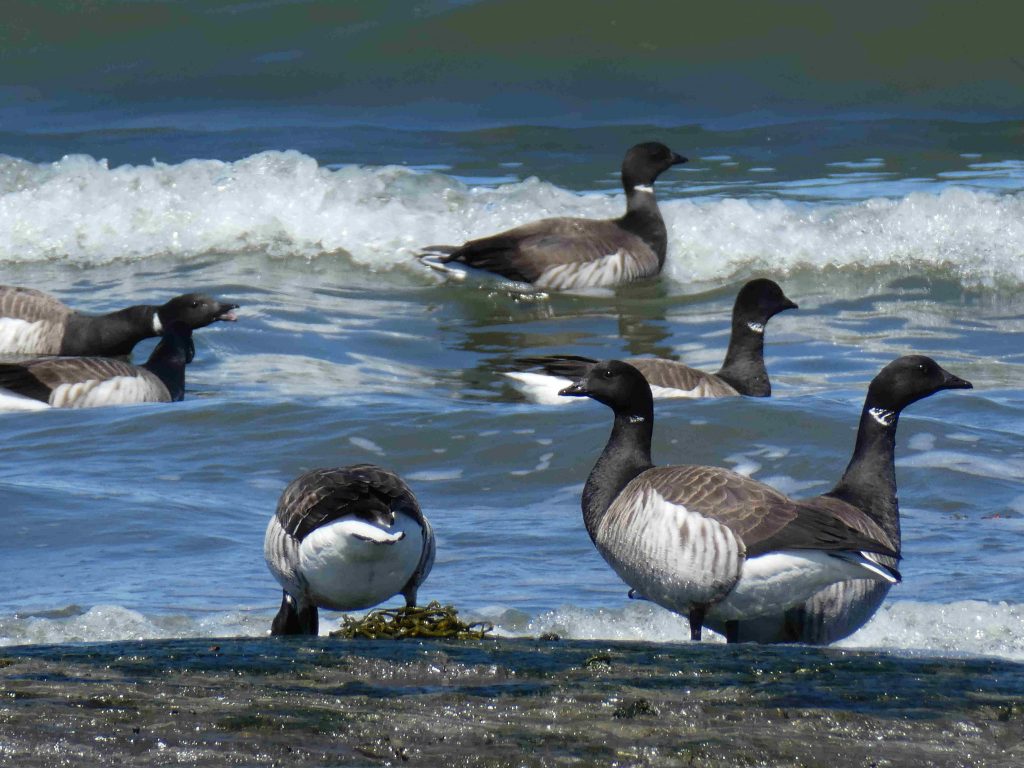
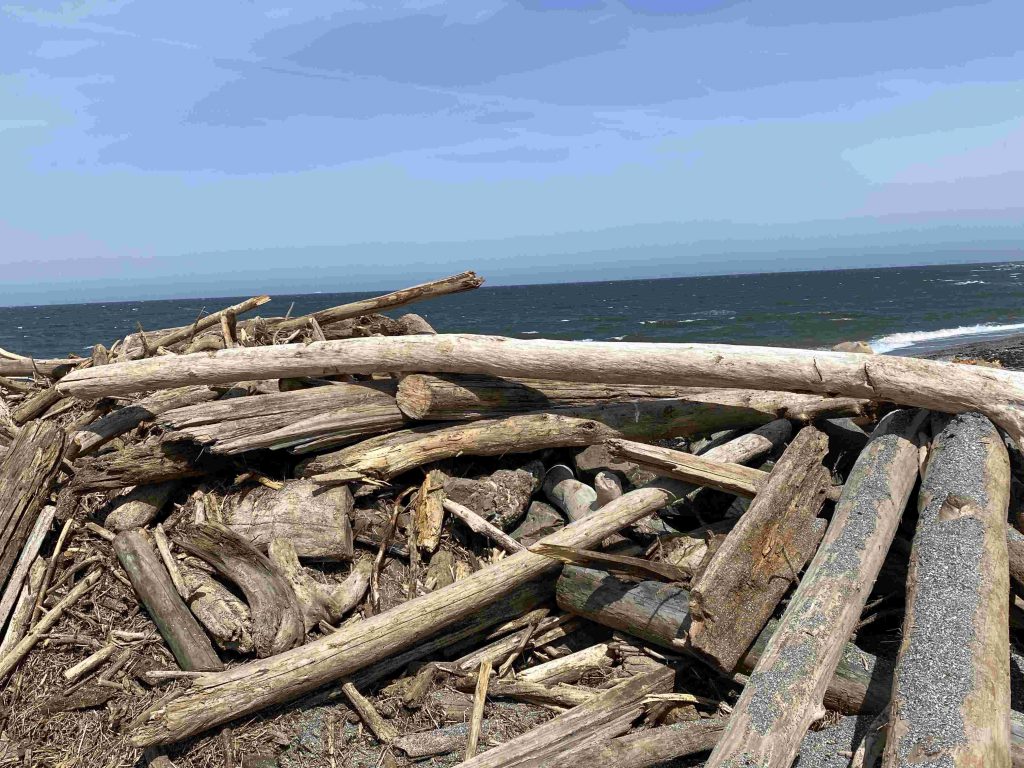




One of the perks of going for walks in the Lower Saint Lawrence region is the marvellous spectacle of bird migration. The mighty Saint Lawrence River, originally named Mijeogun by the Mi’gmaq, is a major stopover point for migrating birds on the Atlantic Flyway. There are numerous spots stretching from Matane to Bic where I like to observe ducks, geese, seagulls, and shorebirds.
In spring, many beautiful sights enhance my feeling of renewal. Tree swallows swirl, dip just above the surface of the water in a bay near the Pointe-au-Père lighthouse. A pair of American wigeons come in for landing as the tide slowly recedes. Their wings make a whistling sound above as I look up. The male’s flashing white wing patches stand out as it swerves in descent. Feet forward, the ducks splash and slide onto the water. If you look carefully, you’ll see a white band that goes down the centre of the forehead over the duck’s head. An elegant posture and greyish-blue beak provide a perfect finishing touch.
As I continue my walk, I reach the other side of the lighthouse where a long beach curves along the shoreline. Groups of brant, eiders, cormorants, and seagulls mingle on rocky outcrops nearby, necks stretched, heads tucked into their wings for a well-deserved rest. Some have reached their destination, others still have a long way ahead before they reach their Arctic nesting grounds. More brant feed near shore in shallow waves, very close to the edge, their pulled-up legs and feet grazing the bottom. The geese are being pulled in and out on the slowly undulating surface near shore, offering no resistance, going with the flow of the ever moving water. Fringes of white froth hem the sandy beach edge. A bit further in, a band of brown seaweed mixed with delicate lacy bits of green plants torn up by the current offer a contrast in colour. Walking over empty mussel shells and urchins, the cracking sound is muffled and cushioned by the wet mounds of seaweed underneath. Slippery bubble sacs branching out from the seaweed pop in the mush beneath my feet. Fresh smells of the sea’s garden fill the air along with seagull cries and the occasional brant calling out. A song sparrow’s bright cheery melody breaks through the breeze as wavelets crash to shore.
The river bestows and the river nurtures. Indeed, the Saint Lawrence Estuary is a major stop on the flight path of hundreds of thousands of migrating birds. It provides a resting area rich in nutrients before the long crossing which will ultimately lead to nesting grounds in the North, since time immemorial.
My eyes wander to the enormous piles of debris amassed high up on the mangled shoreline. The Saint Lawrence River has its benevolent aspects but it can also unleash staggering power with devastating results.
One example is how the winds can ally themselves with the tides of the Saint Lawrence to wreak havoc along the coast. In recent years, the ice cover has formed later in the fall and melted prematurely in the spring; causing the full force of thrashing waves to crash directly onto shore. Without the ice acting as a barrier to slow down and limit the impact of the waves, the unchecked tides carry all manner of debris with them onto the land. Heavy and waterlogged uprooted trees, logs upon logs, and massive stumps are transported by this phenomenal combined strength of wind and tides. Docks are damaged, fences pushed over, steps leading down to beaches smashed, picnic tables crushed, land eroded, and further from the shoreline, basements are flooded from the saturated water table.
When the tides recede back to normal levels and all the snow has melted in the spring, we are left with the chaotic spectacle generated by the rage of the Saint Lawrence. It is a tangible sign of the impact of climate change on our lives. Efforts to subjugate our planet are futile. Rather, our destructive actions are turning back against us, devastating much that we value and need in order to survive. The Saint Lawrence River is much more formidable than we ever will be.
With these impressions coursing through my mind, I head home after an invigorating and thought-provoking walk. It’s obvious we need to take action regarding the changing climate and its consequences, but I am hopeful. I see awareness among the young and old around me. I see youth taking a stand which is encouraging and heartening. My mind returns to the subject of migration. The hardy shorebirds haven’t shown up yet and I look forward to another walk in a few days, perhaps to witness the first arrivals of plovers and sandpipers.
“July, 1953.”

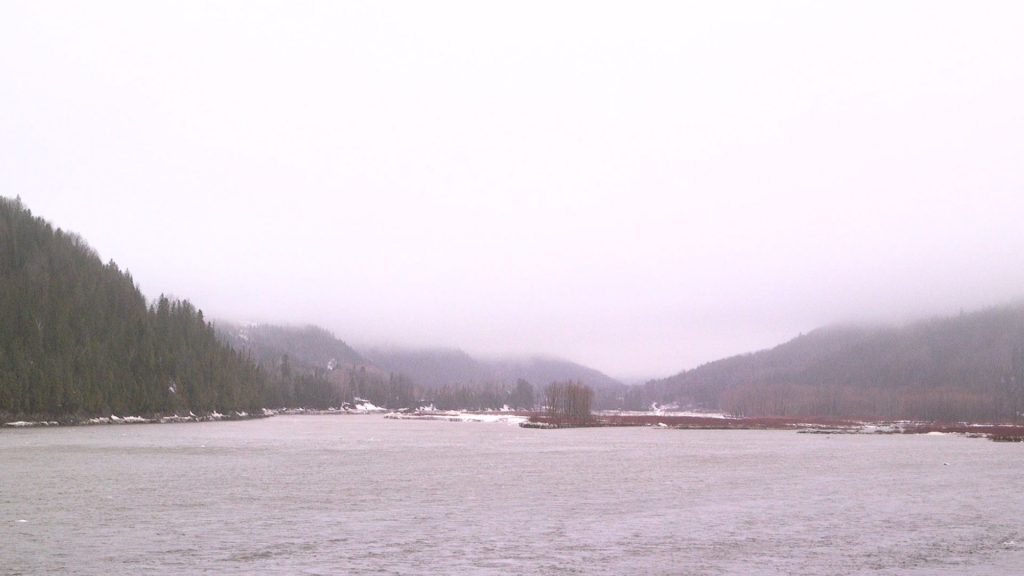

“July, 1953.” – naakita f.k.



Haunting is synonymous with fluidity.
When working with documents from times before,
worlds daisy-chain in surprising ways.
Ghosts survive far beyond what you or I will be able to know or participate in,
and those created in this world will continue to haunt all others.
(Some traces never disappear.)
I came here to ask questions from those who survive this place,
To receive what the hauntings teach,
And negotiate what translation across material properties might look like.
A process that involves the necessary work of attunement,
inviting inward, looking outward, sitting, waiting, cracking open.
It didn’t take long for them to show me their ghosts,
Portals opening into more-than-human temporalities,
A collapsing and convening of timelines that usually exist in parallel to each other.
Un-tethered, un-occupied, un-disciplined land, made from shifting and slipping between worlds.
Being a ghost is hard work!
When they make an effort to be here, your attention is due.
Here in letters not my own, I am continuously confronted by voices, stories and memories.
Over time they become spectral, inevitably and intentionally layered.
There are two voices that have visited in repetition.
The conditions for their exits from this world stem from the capital, colonial, imperial systems this country as we know it was born from.
And for those same reasons, the conditions for their legacies have been cared for differently.
One of their ghosts, we can imagine, remains unsettled.
Ghosts and hauntings flow freely, not subject to the power of choice and dismissal that valorizes some lives over others. Their very existence can be a tool to imagine life beyond the violence that created this place, and beyond the limits of living as it has been prescribed.
What are the conditions that foreground this place?
What are the conditions that brought and keep you here?
What are the conditions we need for desirable and livable futures?
When the answers returned to me they were still breathing and beating.
These ghosts have been generous with their time, stories, and energy.
I share with you their silhouettes,
the connections I built around them through careful, conscious, diligent acts of parsing, combing, mapping, and peeking between tears in worlds.
And then the ghosts said stop.
A message I chose to heed, because they too deserve respect.
Now I am at a standstill with what has been learned here.
*
“July, 1953.”
some context – naakita f.k.
This piece is the culmination of months spent working within thousands of telegrams found in the attic of Matapedia’s train station. It is the result of being surrounded by ghosts, tracing their legacies, and through that process, receiving more teachings than I could responsibly share.
It is one element of “July, 1953.”—an audio, print media and video installation created through archival, historic and community research conducted in the region during winter 2023. Through examining the area’s long history as a resource tourism destination for the wealthy elite, “July, 1953.” works to unravel the events and visitors of one summer. The work uses the lens of the haunting as a form of annotation to explore how these specific pasts have come to impact contemporary social, political, and environmental contexts. It is told as a ghost story, a reminder that pasts haunt the presents we know and the futures we have not yet met.
This project was developed during my time as artist in residence at Gare de Matapedia, a historic train station turned community and artistic hub developed in partnership between Quartier Éphémère and Vaste et Vague. My gratitude to their teams and to the people and communities of Gespe’gewa’gi for their care, generosity, and invaluable support in the creation of this work, as well as to Lindsay Leblanc, my dear friend and editor who helped me bring this text to fruition.
Bic Harbour Massacres

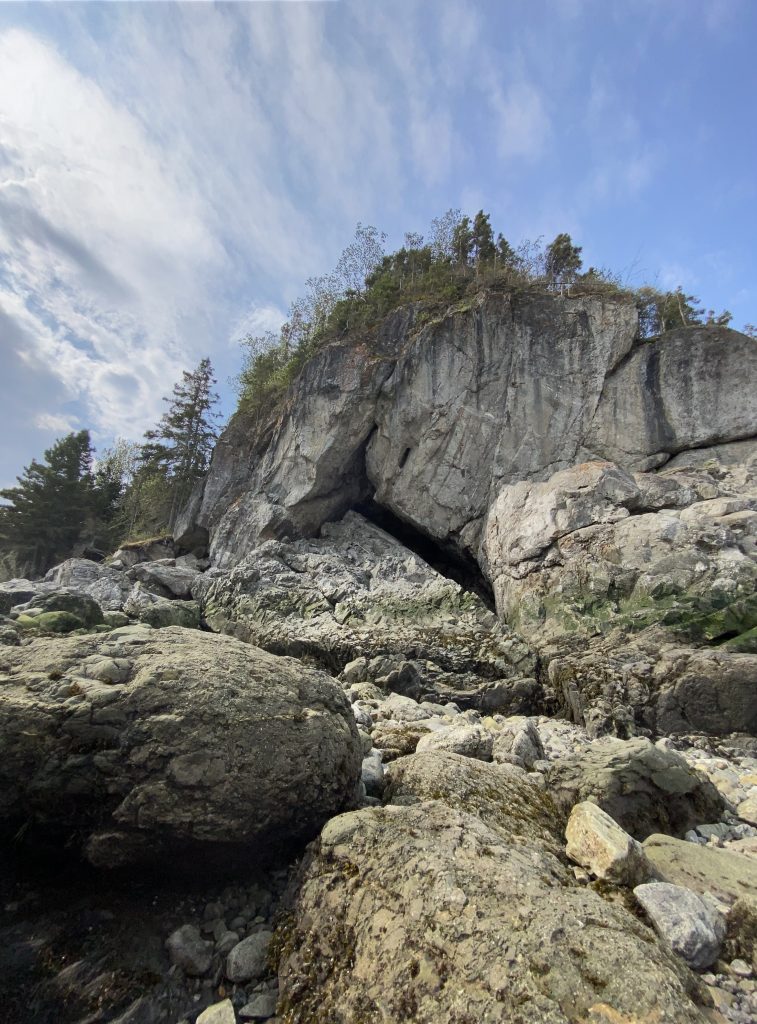
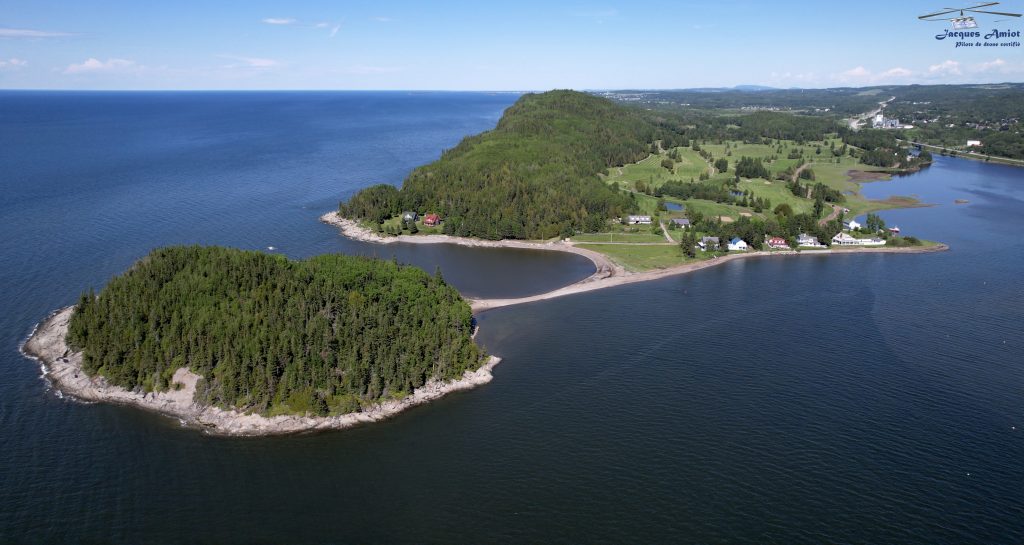



I live beside the Saint Lawrence Estuary opposite an island bearing the name of Massacre Island. The massacre for which it is named took place before Jacques Cartier arrived here on his second voyage of “discovery.” He spent a day or so anchored in a natural deep-water harbour in Bic.
Whilst there he wrote a detailed description of what he observed around him. He met Indigenous people of the Mi’gmaq tribe who recounted the tragedy. Their ancestors were being pursued by warmongering Iroquois and so the Mi’gmaq concealed themselves in a cave on the north or sea-facing side of the island. The tide came in, and they thought they were safe. But the Iroquois were biding their time, and when the tide receded, they built fires around the entrance to the cave. When the Mi’gmaq, overcome by smoke, staggered out of the cave, most of them were slaughtered and the others captured and taken as slaves.
That is the massacre which is well known and frequently recounted. But in a book written in 1901 by William Carson Woods (translated from the original by J. C. Taché) it would appear that the Mi’gmaq later retaliated and took equally cruel revenge on the Iroquois.
However, there have been other massacres. At some stage, a brilliant idea was hatched. A bridge was built, connecting Massacre Island and the end of the Pointe-aux-Anglais. The water is shallow here and, at low tide, the beach emerges and the island can be reached on foot. The bridge was built and that summer the historical site of the Mi’gmaq massacre was blasted and granite removed to build a deep-water dock in the Bic harbour. No thought seems to have been given to the structure or positioning of the bridge to Massacre Island. And no thought given to destroying a historical site and the vestiges it could have shared with future generations. The following spring, the bridge was destroyed by ice and strong tides. The remains of the bridge can be seen to this day, but the cave where the terrified Mi’gmaq sheltered is gone forever.
I don’t know how long the deep-water dock survived, but there remain no signs of it now. In my humble opinion, the two efforts of construction were badly thought out and constitute two more massacres in their own right.
In December 2010, this area suffered a major storm. There was no ice to protect the shore, a rare occurrence. The abnormally high tides wreaked havoc all along the coast and changed it forever. My land goes down to the high tide level, so I lost a bit that year, and the erosion continues so I lose a little every disastrous high tide like the one we had last Christmas. I had never been flooded but I had a foot and a half of water in my basement. This was another disaster or massacre for me.
However, since that time, a sand bar has gradually built up between Massacre Island and the mainland, a grain of sand at a time. Over the years these grains of sand have built a bridge to Massacre Island so that it is accessible on foot, even at high tide.
I have lived here since the early 1980s before the Parc national du Bic opened and the news is not all bad. More and more people take an interest in the climate, and preserving the beauty of our water and shoreline. When I first moved here I used to take a bag to pick up debris when I walked on the beach. I wonder how many condoms and tampon sheathes I have removed from the beach along with bottles and bits of glass and plastic. Times have changed, and I rarely find rubbish on the beach now. People are taking more care of what nature has to offer us.
My children, my grandchildren and my great-grandchildren have shared the joy of exploring the shore with its rock pools, sand and mud. Holding little sea creatures in their tiny hands, these children have spent many happy hours connecting with nature. And this connection will be with them for the rest of their lives. They meet other children on the beach and quickly make friends in their pursuit of happiness. This is where they learn to love and cherish the mighty Saint Lawrence and its shores. Hopefully they will learn to respect it and thus avoid any more massacres.
A Letter Left Unopened
Standing on the shore, struck by immensity,
I suffocate.
Images fill my head, as I drown in a self-destructing current,
vainly trying to fight against it
since the River is the Master.
Time runs like a furious river, slips like sand from your hand. Do you remember our last walk on the shore? You were preoccupied, anxious, angry maybe, mixing everything in anything with nothing, mad at the universe.
The River makes its own world.
Quiet, peaceful, digging its bed of clay.
But the same day,
look how it moves; waves breaking on rocks,
carving water in mesmerizing sparks of light,
haunting noises, chanting endless incantations,
the remnants and the remains left behind.
Bottles, bags of chips, and this poor bird
strangled by its new plastic collar.
I suffocate.
I was listening as carefully as I could, even if I did not really see you, this strong young man. My mind was building stories from sparks of light, from clay, from rocks and remains haunted by your voice. In this mosaic of blond hair, piercing grey-blue eyes, nonchalant teenage years, I saw you from too close up to really know you.
The River is the Dominion.
From an inch-large stream, from a quiet lake,
reaching valleys and cities.
Everlasting.
Even in beauty, danger arises;
cruel is the Master.
From time to time, yesterday, last month, tomorrow,
people drown, trapped in a wall of water,
like these migrants, escaping, fleeing, hoping for a better life.
Among the drowned, a boy, two years old.
I picture him with your eyes.
Is he the cost of that better life?
The River will remember their names.
Lucky are the ones who fall asleep in its arms,
even if they did not choose to end up with it.
In its strong current, in the rapids, in the waves,
their souls rest gently, rocked by the tide.
Now I see you as a whole, all ages blended together creating something I call: your life. I walk alone today; my hair is grey. My sight, my hearing are not so great anymore. I’m old and you never will be.
I see people cleaning the shores, I see people planting trees to restore the banks, to keep them in place.
But I also see a forgotten boat agonizing on the shore,
bleeding oil, liquefying itself;
mixing rust and dust and filth
with water.
I suffocate.
You found the River so beautiful, at the end, you choose to be with it. Your life in pictures played like a furious carousel as you tried to grasp a last breath.
There was dirt in your hair, your eyes were closed.
I’m not sad anymore, some days, the River has your grey-blue eyes.
Did it break your fall?
Did it wash your pain away?
Did you think of me?
Wake-up Call


Toward morning I awoke to hear my husband breathing strangely. For a while I lay there, wondering if something was wrong. Everything had been going smoothly on this working holiday, but this was the summer of 2021 and the pandemic of COVID-19 still cast long shadows on our lives.
A list of dreadful possiblities doomscrolled through my head. Maybe he’d come down with the Disease, maybe he’d had some sort of seizure. I lay there fretting and listening for what seemed a long time. Then I got up and went over to look out the window. Down below, the beach we had walked on before we went to bed was gone, and the sound, I realized, was that of waves lapping at the bottom of the cliff on which our inn stood.
The tide had come in during the night!
Only the tide.
For a moment I was reassured, and went back to bed. Then the enormity of what was happening down below rushed over me like a cold wave. Given a storm like the one that thrashed the Lower Saint Lawrence region in 2010, this inn was in danger from waves that would not stop at this morning’s high tide mark, but come crashing onto the shore. Something needed to be done.
I shouldn’t have been surprised, of course. The reason for our trip was to do research for my book, Against the Seas: Saving Civilizations from Rising Waters. To the east, the small town of Sainte-Flavie was in the middle of an ambitious program to move at-risk buildings away from the shoreline. Following that 2010 storm which served as a wake-up call, the town and its neighbour Sainte-Luce surveyed properties for a thirty-kilometre stretch along the shore to determine which ones were likely to be badly damaged in the future as sea levels rise and the number of drastic weather events increase. They passed regulations forbidding new construction in the zone, and limiting what could be rebuilt after a major storm. Then, Sainte-Flavie began offering affected property owners a buy-out plan. With the help of Quebec provincical government funds, the town offered a choice: they could stay and take their chances but would receive nothing if their property was damaged; they could get up to $250,000 to move their houses to higher ground, or they could leave their houses behind and get up to $250,000 to re-establish elsewhere.
City officials in that summer of 2021 were justly pleased with how it was going: about twenty of the thirty properties identified had signed on and the freed-up land was becoming a water-front park. Since then, Sainte-Luce has undertaken something similar, and in March 2023 the provincial government announced $67.3 million for plans in eight communities aimed at protecting them from coastal erosion and, in some cases, instituting strategic retreat projects similar to Sainte-Flavie’s.
The initiatives are the kind of thing that a recent study from the federal government’s Disaster Financial Assistance Arrangements (DFAA) endorses. For more than fifty years, DFAA has provided financial support for response and reconstruction costs after disasters to provinces and territories. The report says it is high time to review both the ways that aid is allocated and how damage can be avoided in the future. It suggests nation-wide standards for flood-damage reduction, although at the moment the federal program couldn’t enforce such standards were they to be adopted. Likewise, the kind of strategic retreat pioneered in Sainte-Flavie is beyond the DFAA’s purview. Indeed, the DFAA has come to serve as “de facto insurance” and “the funder of last resort” all across the country, picking up the pieces when no one else will. That’s no way to discourage building and rebuilding in floodable areas, but doing just that is what we’re going to have to undertake more and more frequently.
We went walking along the beach when the sun was fully up that summer day in 2021. The tide was going out by then. We followed the high water mark, staying close to the riprap barrier that protected the buildings on top of the cliff. There were tide pools, and multicoloured rocks jutting out of the sand in places. Strange to think that all of this was under ice ten thousand years ago, and millions of years before that the rocks were still being squeezed and compressed in the earth.
Without a doubt, the landscape has changed immensely, and today global warming is accelerating change. Ignoring the process will not make it go away. It would be far wiser to take stock of what is happening and move appropriately. In many cases that will literally mean moving; moving away from the shore, like the folks in Sainte-Flavie who got out while the getting was good.
For some this could be a nightmare, but for others, it will only mean waking up to reality. I know what I’d choose. No nightmares for me.
Betwixt Between

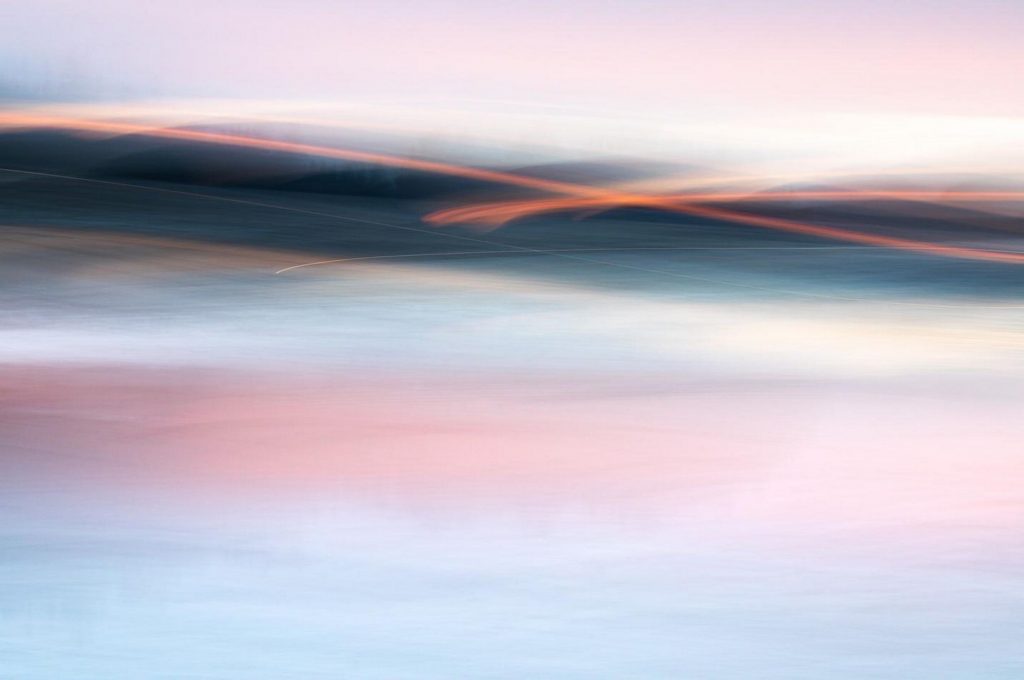


I spent the greater part of the 2010s climbing to the top of wind turbines. My job was to photograph Quebec’s energy transition, primarily on construction sites located in the Lower Saint Lawrence and Gaspésie regions.
How I loved to linger on top of the turbines! While the electricians, mechanics, and iron workers finished the installation inside the nacelle, I would squeeze through the roof hatch and tether myself to the turbine’s anchor points.
Standing one hundred metres above the ground, surrounded by wind and clouds, helped me to “see” the energy transition from a different perspective. I eventually came to understand that the transition from fossil fuels to renewables is not just about wind turbines, solar panels, and electric vehicles. It is, more profoundly, about us.
Technological infrastructure alone does not an energy transition make.
What’s missing from the conversation is recognition of the important shift in social norms and cultural values that we’re currently living through—a shift without which the current energy transition would not be possible. I call this missing component of the energy transition the “human transition.” By this I mean an unquenchable thirst to break free from the chains of our fossilized ways of thinking.
We humans have survived many energy transitions throughout the ages, and we’ll definitely find the moxie to do so again. If we’ve learned anything from previous energy transitions—from wood to coal; from wind to steam; from coal to oil—it is this: all energy transitions are liminal. The word liminal derives from the Latin limen, meaning a threshold.
The German philosopher Karl Jaspers described liminal periods of crisis or societal collapse as “an in-between period between two structured world-views, between two rounds of empire building.” Jaspers recognized that these periods of crisis or collapse are of extreme historical importance, because that is when “Man asked radical questions.” And only when we start asking radical questions can these liminal moments lead to significant social change.
We are in such a liminal moment right now. This is when, according to Jaspers, “the unquestioned grasp on life is loosened.” In the past, that grasp was often the divine right of kings, whose omnipotence surely must have seemed inescapable to feudal peasants. Today, it’s the vice grip of the fossil fuel industry. Too many people believe, or have been convinced to believe, that it would be impossible to live without fossil fuels. But this world-view is slowly being chipped away. The fossil fuel industry’s once invincible vice grip is full of cracks; it can’t stop Leonard Cohen’s light from getting in.
Liminal moments are inherently ambiguous and volatile. They are periods of not knowing—of being betwixt and between—like the first year of the COVID-19 pandemic. The philosopher and founder of the Social Imaginaries Project, Samantha Earle, describes liminal space as “a time of radical uncertainty, where the foundational concepts of the way in which we’ve been living and around which society is organized, no longer makes sense.”
With regard to energy transitions, liminality does not give us answers. It does, however, show us that we have choices where none seemed to exist before. Standing at the threshold between two possible futures as we approach multiple climatic tipping points, we suddenly realize there is no script to follow, no roadmap. Destination unknown. Therein lies the key to understanding the transformative power of liminal moments such as ours: transformation does not happen at the end of the journey—it happens during the passage across the metaphorical bridge between what was and what’s next.
This is why I stopped photographing the energy transition: I had become obsessed with the destination. I was blinded by the shiny promise that technology would somehow magically save us from ourselves. I was ignoring the journey across the bridge, a journey of becoming rather than of being.
Since then, my artistic practice has changed radically. Beginning in 2019, I felt the need to liberate myself from the constraints of documentary photography. Abandoning my tripod, I began experimenting with embodiment as a way to enmesh myself with the more-than-human world. My current long-term photo project, Becoming River, explores the impact of climate change on the Saint Lawrence River in a phenomenological way. Each winter, I dive symbolically into the river where once the ice was thick and strong. There, in the liminal space between liquid and solid, between despair and hope, I move my camera chaotically to embody the chaos of the climate emergency. I discover an ephemeral beauty of a river undergoing profound change. This beauty confuses me; I expected chaos to be dark and ugly. Becoming River has shown me that I am not separate from climate change; I am part of it. That I am not separate from this river; I am river.
This is my journey: to learn to embrace the unknown with humility rather than hubris.
Sources: Music Inspired by the St. Lawrence River
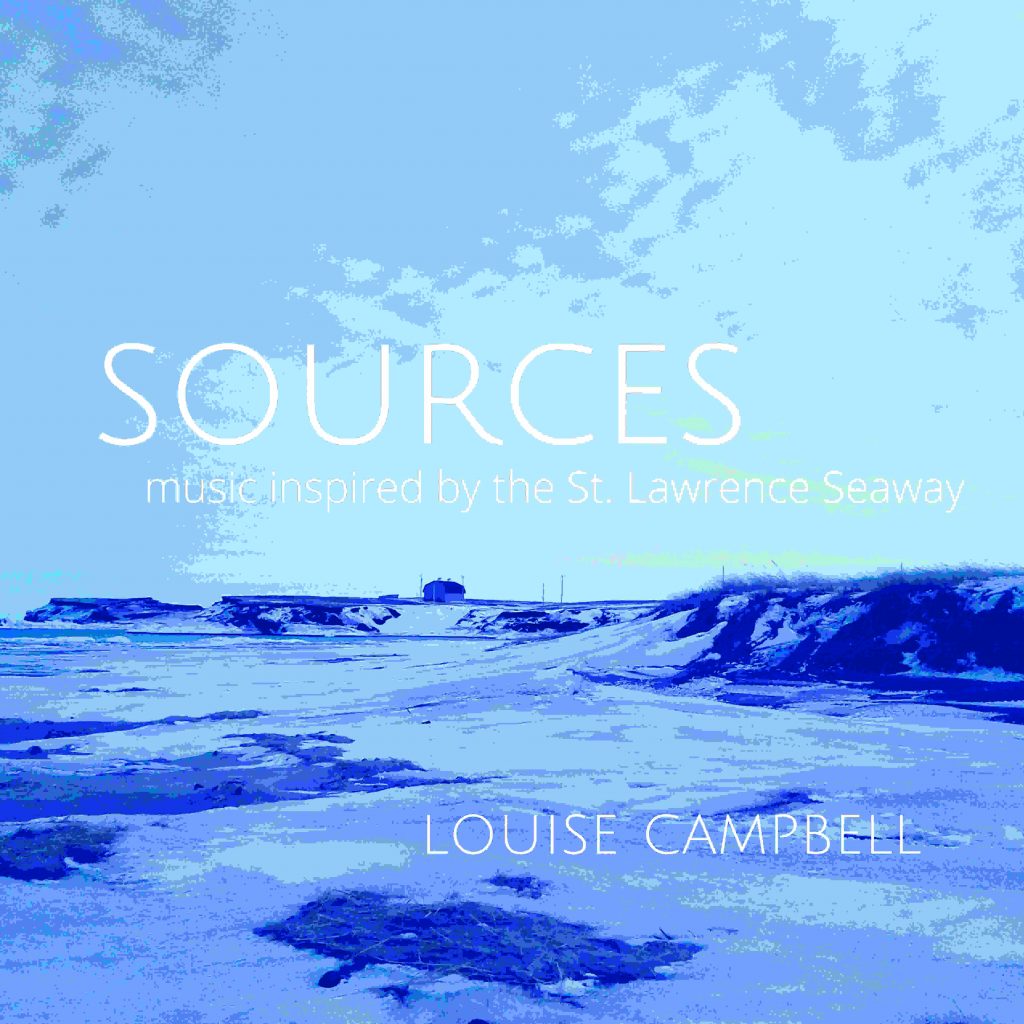
Songbird – Louise Campbell

A long-time Montrealer, as much as I love the bustle and vibrancy of my hometown, I crave spending time in nature. I have adopted long-distance bike touring as my means of immersing myself in the elements. During these trips, I’ve always been drawn to the Saint Lawrence River–its beauty, grandeur, ever changing ecosystems, and the ways in which human life and livelihood are defined by this vast waterway.
On these bike trips, I discovered that returning to my love of nature somehow equals returning to my creative sources as well. As the busy-ness of city life drops behind me with each turn of the wheel, I listen to the sounds around me. Time and space opens up in my imagination for music to happen.
Sources, a cycle of works for clarinet and electronics inspired by the Saint Lawrence River, is a result of my time spent along this waterway. This album traces the Saint Lawrence from its headwaters in Georgian Bay, through the bird sanctuaries of the Saint Lawrence Parks Commission and the Old Port of Montreal, to the Magdalen Islands where the Gulf of Saint Lawrence flows into the Atlantic Ocean.
The first work of the cycle, “Songbird,” draws inspiration from my first bike trip along the coast of Georgian Bay. As anyone who has spent any time sleeping in a tent knows, nature is anything but peaceful and quiet; it is frequently very noisy, especially at daybreak when the birds start to sing. I spent this trip listening to birds, biking between beaches, and learning with alarm about water politics in relation to the Great Lakes. This work taps into the cacophonous, alarming and sublime sounds I encountered on that trip.
My hope is that this album, its companion outdoor installation and cultural mediation activities will encourage and deepen listeners’ reflection on their own sense of place and connection with waterways. Click HERE to listen to the album, from headwaters of the Saint Lawrence to the Atlantic Ocean. Bonne écoute!
*
Montréal’s Louise Campbell is a musical polymath, and her debut full-length release Sources skilfully weaves together several of the main threads of her multifarious artistic practice. Campbell’s primary instrument is the clarinet, and over the course of the four pieces on this album, she constructs rich yet spacious sonic environments, attentively layering and shaping the instrument’s characteristic pure tone through the aid of surreptitious processing. As the opening work “Songbird” slowly burgeons, her uncanny insight into blending with herself is revealed—undoubtedly a product of her considerable experience as an improviser. She folds delicate microtonal sighs, fluttering textures, and distant echoes into to a single evocative image. The other works are similarly grounded by her intimate knowledge of her instrument and draw upon her unconventional mastery of ensemble composition. Each of them takes great care in establishing a vivid sonic world, before pivoting, offering myriad unexpected pathways to the listener. While this collection exhibits both her compositional wherewithal and gifts as a player, there’s another dimension to it that is nourished by sources outside of the strictly musical realm.
The Whale Encounter
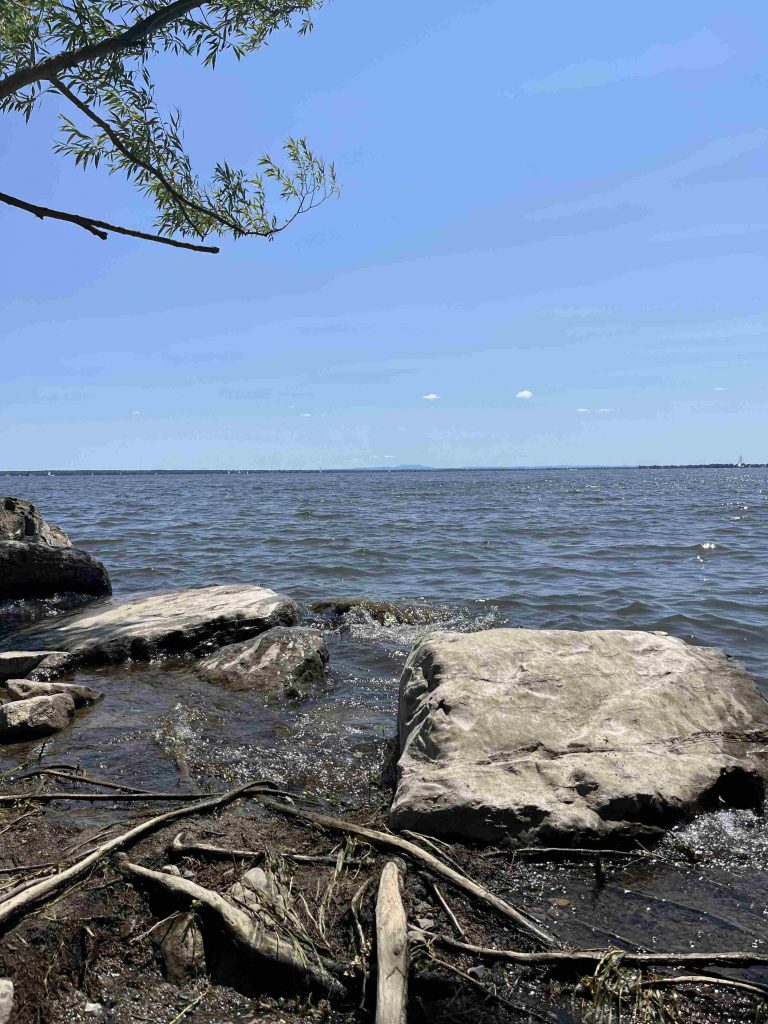

The weather has warmed up as the seasons switch from winter to spring. It’s now sunny with a nice breeze. Everyone seems to be out and about enjoying themselves by the water. There are people walking hand in hand along the river banks, and others are skateboarding or riding scooters. I’m out on the water in a kayak, with my mates. It’s crazy to think that this time a few months ago, I was walking out here on the ice. This is my first time in a kayak. I’ve paddleboarded before but never kayaked, so today should be exciting.
Delta invited three of us to join her on a surveying expedition of the wildlife in and along the river. Delta’s a wildlife biologist, so part of her job is tracking the number of different animal species in the area. Some species are endangered, and it’s important to know how they’re doing and if they’re thriving. Today’s goal is to see a whale or two, as this part of the Saint Lawrence River is where you can find many species of whales. Including belugas, fin whales, and blue whales. We’ll also be keeping a lookout for seals, dolphins, and other wildlife.
We’re enjoying ourselves, paddling and splashing one another while keeping track of the wildlife we see on our clipboards. My clipboard is to record the seals. Delta is recording the whales and dolphins. James is recording the varied species of birds as he knows the most about those. And Andy is recording the other wildlife we spot. We’re also taking as many photos of the wildlife as we can so that we’ve got pictures to accompany our reports.
It’s been an hour out here on the water and the only wildlife we’ve seen are fish and seals. There are also a couple sailboats out and about, along with others on kayaks and paddleboards. Seals are cool, but fish and boats are boring. I can’t wait until we get to see a whale. This was the main reason that I decided to help out. We’re out of the main area where people hang out, so now it’s very calm and quiet—except for our conversations about the things going on in our lives. Andy has spent at least ten minutes complaining about the people and company for which they work. We all suggested that they quit and find a job they enjoy more, but Andy doesn’t think that’s a clever idea, for whatever reason.
We were all in deep conversation about our favourite books when we heard a big SPLASH. We fell silent and looked in the direction of the sound. There we see a couple of dolphins or whales. We have to get closer to be able to identify them, but this is a good start. We start paddling faster, being sure to cause as small of a disturbance as possible. We make our way toward the creatures (which turn out to be fin whales) when we notice that they seem to be in distress. Why? I can’t tell. Delta carefully stands up in her kayak and points out exclaiming,
“The whales are caught in a fishing net!”
“Oh no!” The rest of us say in unison.
“What are we going to do?” James inquires.
I suggest, “We could swim up to them and try not to spook them as we try and cut the net off of them as carefully as possible.”
“That’s a great idea, Millie! I’ve got a pocket knife, and I’m a stronger swimmer than you guys. I’ll get as close as possible to the whales, then dive in and do my best to cut them free.”
As Delta says this, she’s pulling off her shirt and rummaging around for her knife. Before we know it, Delta is in the water swimming close next to the whales.
The rest of us stay back in our kayaks listening to see if Delta needs help. “Why can’t fishermen keep their nets away from the whales and other creatures who don’t need to be caught?” Andy sighs.
“I don’t know. It would be good if this didn’t happen,” James says.
“I agree,” Andy and I respond.
Soon, Delta is back, dragging the net behind her.
“You got it off?” we inquire.
“Yep. I’m just going to call my boss and let him know about what happened.”
We wait for Delta to get off the phone and get ready to return to shore. The paddle back is filled with joy as we just saved those two whales. Hopefully, they don’t get caught in nets again.
‘We’re like a laboratory for climate change’- an interview with Alexander Reford
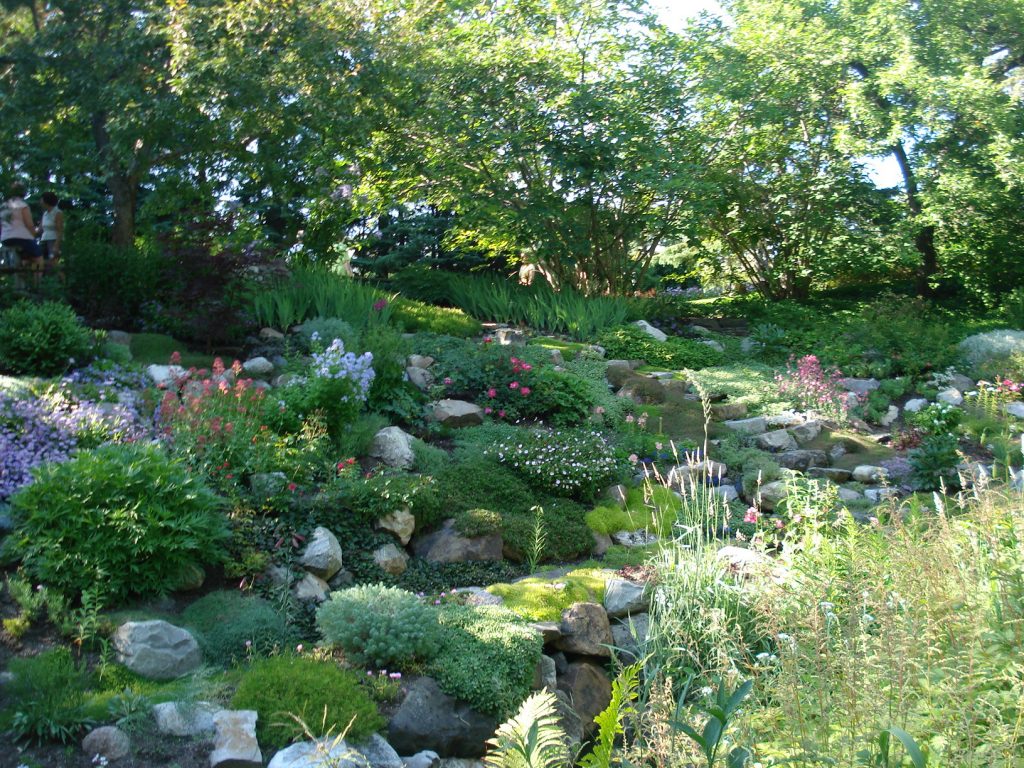



Director of the Reford Gardens//Les Jardins de Métis, Alexander Reford, in conversation with Font Editor-in-Chief Rachel McCrum.
Q: Tell me more about your own personal history with the Gardens.
Completely unplanned. I grew up in the Aylmer-Outaouais region of Western Quebec, then university in Toronto, then finished my studies at Oxford University. Then back to Toronto for my doctoral degree, and to begin my work as a professional historian. [At this time] I offered my services to the Dictionary of Canadian Biography. The two people I’d been working on were my two great-great-grandfathers. I was researching their lives and went to Montreal, and there in this dusty room, were boxes and boxes of documents. While I was meant to be writing one project, I started opening all the other boxes and what I found was all the Garden materials. Photographs, diaries, invoices, plant drawings … all kinds of stuff which had been dormant for forty years. I thought, I’ll write a little book about the Gardens. And having had that idea as a starting point, I thought I’d better go and see the Gardens, which I really didn’t know all that well.
My family sold the property in 1961. [My grandfather’s] mother [Elsie Reford] had left him this massive garden but no resources. So the Government of Quebec, in the early years of the Quiet Revolution, was purchasing all kinds of heritage sites, and this was one of their first major acquisitions, to promote tourism in Quebec. We owe [them] the preservation of the site and vision of opening it to the public, because my family had never opened it to anybody. I came here in the fall of 1993, to say ‘can I write a book?’ and the Director, who was working for the [Quebec] government, said ‘Sure, would love to know more, what’s your project? We don’t have any money, we’re going downhill …’.
Government Parks were going from conservation to a whole new recreational approach, which was a radical shift in the park world. Parks and Gardens are often combined because they’re run by the same entities but in fact, they’re very different approaches ecologically. The Park guys are all about preserving the flora and the fauna, the native species … and the Gardens are all about…clean it up, manicured, pristine, perfect. So it’s a very different approach.
So I said ‘how can we help?’ stupidly, and he said ‘you can help by helping this place survive.’ So the book became a secondary subject, and the first project became how do you save this place from annihilation, demolition, destruction, dismantlement and all these words that you hear when we talk about heritage in Canada. I moved here in the spring of 1995; I left my academic career for what I thought would be a short hiatus and here I am, over twenty-five years later. It’s a bit of a life mission.
Q: Your discipline is history, but does botany come into it?
The truth is that we have a very solid and good staff of experienced gardeners. I clean and I cut trees and I pull out branches, but I’m really highly dependent on the high quality of the staff who’ve been with us for a lifetime.
Gardeners are often lifers: they spend their life on a single property. [There’s] this accumulated knowledge that is often intuitive but not written down. So my job in a way is to document what they do, and become their literary voice, if I can say it. And also bring to them the story of the past: they were often, oddly enough, hired with no look backwards, because there were no documents. Through the archival material that we brought from Montreal, we’ve been able to share all this amazing stuff.
My great-grandmother chronicled the story of her Gardens with extraordinary detail: she wrote every day what she was doing.
Q: There’s an incredible amount of artistic activity around the Gardens – every time I write to you, there’s a list of names of people who’ve been working there. When did that become part of the programming?
We made the decision quite early on. We had two different directions, and this was the road not taken. One way would have been to treat the property very like a National Trust and freeze the Gardens and building in its current state. You reconstitute how it would have looked like, you have the upstairs/downstairs stuff, you have the historic house approach. Which can be done very well with a lot of elegance … but we didn’t have a lot of stuff. So we couldn’t do that with authenticity.
The previous Director had welcomed one artist who had done a beautiful sculpture with moss, which was a big attraction and opened the window to how artists can make a physical landscape come alive with their own intervention. I don’t take credit for it: it was there, it worked, people loved it. Since then, we’ve embraced artists as change agents. They bring the change that we can’t offer ourselves; they bring their networks that we can’t necessarily access; they bring materials that we wouldn’t normally use.
It’s been very interesting for us. Yesterday, we had a concert for young violinists and a book launch. We’re trying to connect to the arts [in French and in English] in a broad way: it can be dance, literature, music; it can be composers, landscape architects, circus performers.
These places are not accessible to a lot of people. You’ve got to be a millionaire to get to a shoreline at the present time in this world. We have a shoreline that you can play on, and it doesn’t cost you any money to use it. One of the first things I did was to start a membership program, and now we’ve got about one thousand season pass holders. Some of them buy a membership to support the Gardens financially; some of them come every day. It’s their walk in the woods type of thing. We’ve become part of the ‘Free on Sundays’ program as well, that the Quebec government brought in a couple of years ago which opens up the Gardens to folk who wouldn’t normally come, or wouldn’t have the means to.
Q: How has the growing awareness around climate change changed the approach to the Gardens and conservation?
We’ve certainly shifted a lot in the last twenty years. From Greta Thunberg to belugas washing up on the shoreline, fish stock issues: the Saint Lawrence is a wonderfully complex eco-system, and it’s changing and that is part of our truth. The climate has brought its own challenges: we get big windstorms and wave action, massive tidal events. We’re like a laboratory for climate change. You can quite literally observe it, happening in real time. That’s interesting from a human point of view; it’s frightening when you actually own the property. We have events where we get tonnes and tonnes of debris on the beach: what do you do with it? Do you leave it there, do you move it, do you burn it? We deal with things on an ongoing basis. Picking up one hundred and fifty fallen trees, which we had to do in December: it’s not exactly happy work. We see the destruction.
We’ve become more humble: we do fewer installations on the shoreline, build less stuff. We realize how powerless we are when nature is unfurled; we watch it happen and think ‘why did I think I have power to push back the ocean?’ We’ve changed our practices: pesticide free, we did that early. We used to do a lot of work on our lawns, try and make them pristine: now, we let Nature do what Nature does. We freed the animals, the sheep to maintain the pastures. We embrace the agriculture ecology, grow our own vegetables.
The tough thing is to get humans to change. Changing human behaviour is really tough.
*
Les Jardins de Métis//The Reford Gardens is located in Grand-Métis, on the south shore of the Saint Lawrence River, halfway between Rimouski and Matane. They are currently open from June to October. See their website for information on visits, exhibitions, performances, dining, and more.